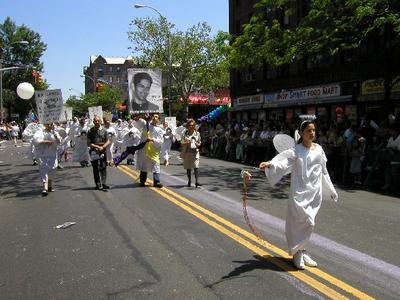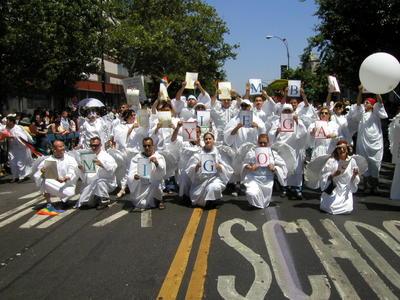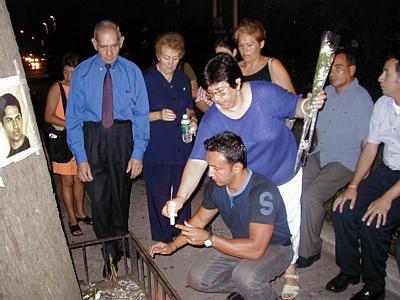


 Images (top to bottom): Three photos from the Queens Pride March in June of 2002 including photos of Leonor and Armando Gatzon leading the COLEGA angels; COLEGA proclaims "Colombia, COLEGA and Friends"; an August 2002 family memorial gathering in front of the site of the attack, Armando and Leonor standing, Marlene Forero with the flowers.
Images (top to bottom): Three photos from the Queens Pride March in June of 2002 including photos of Leonor and Armando Gatzon leading the COLEGA angels; COLEGA proclaims "Colombia, COLEGA and Friends"; an August 2002 family memorial gathering in front of the site of the attack, Armando and Leonor standing, Marlene Forero with the flowers.
I began these blog entries on Eddie Garzon just as the full ugly picture of the Katrina hurricane disaster was becoming clear.
It has been tough to stay on topic but, in some ways, the daily horrors provided a similar back-drop to those traumatic days in 2001 as the fall of the twin towers eclipsed any hope that any additional investigative resources would be destined to solving the his murder – or that many people would pay any attention.
It was unclear how much I’d be able to write on the topic.
I am amazed that I remember so many details (though it must be said that the mind, in seeking narrative logic, sometimes neglects some key details while high-lighting others – there must be other perspectives out there and some recollections might be different than mine or outright contradict some of the stuff I have written down).
The fact is that it is four years later and his killers are still out there.
Eddie’s murder galvanized the Colombian Lesbian and Gay Association (COLEGA). Though I retired from its board and as director, my boyfriend Raul took the reins. Marlene Forero, who had been one of Eddie’s closest friends, joined the Board of Directors as a straight ally. New people became involved not only on the Board level but also as members.
In the meantime, Eddie’s parents continued to seek answers while they also had to address their immigration status and other family situations. Some tensions developed between the family and former friends of Eddie’s as the family aligned itself with a certain number of people but not with others. Some feelings were hurt but it was almost impossible to avoid this particularly because Eddie’s parents had to basically reconstruct their son’s life in New York after his passing. The fact that they were not fluent in English also created some obstacles. Through it all, it was Leonor Garzon’s tenacity that seemed to sustain the family.
Sometimes those of us involved with COLEGA and the Garzon family grew distant, and at other times we worked closely with them. There were lingering feelings that the family felt uncomfortable with the fact that their son’s sexual identity was exposed so publicly during such a traumatic event; a sense that while they could accept this, it was still something else for extended family members and friends in Colombia to be able to somehow find out. Some people in the community continued to accuse them of being homophobic but I would tell them that dealing with a son’s coming out was hard enough for parents anywhere, much less in these circumstances (worse, I thought, were those gay men who said that maybe Eddie had brought the attack on himself for being out in the streets so late; NO ONE DESERVES TO BE BASHED IN THE HEAD WITH A BAT).
As the shock of the fall of the towers subsided, several developments were taking place under the surface. At community meetings with the new head of the Hate Crimes Task Force during efforts to improve their relationship with the LGBT community, I continued to bring the case to light. As a matter of fact, some of the people who made sure that the case remained under investigation were lesbian and gay members of the New York Police Department such as Detective Kevin Czartoryski, who was one of the first detectives assigned to the case, and (since-retired) Officer Vanessa Ferro, among others. The New York City Anti-Violence Project also worked closely with the police department and the family to keep a spot-light on the murder. Latino LGBT organizations, who had been so supportive of the rally, also helped to keep the case alive. Less can be said, though, about the 115th Police Precinct in Jackson Heights, which went through several changes in leadership, assigned different officers to the case, and fumbled attempts to communicate with the Garzon family. It seemed as if every time that the family contacted them, they would have to go over details of the case all over again. At one point, a computer that they had taken from Eddie’s apartment as part of their investigation seemed to get lost and, when found after repeated requests from the family, its hard drive had been completely erased.
Over the years COLEGA tried to raise awareness about the case with varying degrees of success. Queens used to be home to the first celebration of the gay pride season in the New York City metropolitan area by scheduling it on the first Sunday of June (until Staten Island launched their pride event earlier this year and scheduled it for the 1st Saturday in June). Although participants and spectators have been on the decline, it still remains a unique event distinguished by the fact that most of the people that line up the streets to watch are straight families and neighbor residents and the fact that it cuts across a hugely diverse swath of Jackson Heights (along 37th Avenue through Pakistani, Colombian, Argentinean, Indian, Afghani, Mexican and Turkish restaurants and venues).
During the summer of 2002, HBO started to run “The Laramie Project,” a dramatized version of a Broadway play, in which actors portrayed a number of different people interviewed in Laramie, Wyoming, in the aftermath of Matthew Sheppard’s murder. In a powerful scene, members of a rabidly homophobic Baptist church set up camp outside Matthew Sheppard’s funeral and the media, as expected, swarm around them to capture images of their hateful signs. Friends of Matthew, who had struggled with how to defuse the hateful messages get a brilliant idea: They don long white tunics and large angel wings which they unfurl as they form a circle around the anti-gay protesters and block their signs from the media.
That’s when Raul got the idea that COLEGA would march at the 2002 Queens Pride parade dressed as angels and demand justice for Eddie, ten months after his death.
The idea caught fire. Friends of Eddie not involved with COLEGA, former members of COLEGA and others joined in. People donated their time to sew dozens of angel tunics. Marlene was amazing, calling on her friends for support and help. Eddie, who definitely liked to create something memorable for COLEGA’s previous pride marches, would have been proud. On the actual day of the parade, we all looked beautiful. A stunning crowd of angels in white, with little angel wings, carrying signs demanding justice and rememberance started congregating on a Jackson Heights corner on a beautifully sunny Sunday, blue skies above us.
And then… And then… A miracle
The Garzons, who had been rumored to be weighing whether to march with COLEGA or not, actually showed up. Each holding the same black and white photograph of their son’s face, each in somber toned clothes.
They, in fact, led the contingent.
Most people on the sidelines seemed intrigued by the scene but only when they begun to read the signs did they realize what the message was. Some people seemed to recognize Eddie’s photo and I could see people on the sidelines gasp and hold their hands to their mouth.
Now, the parade route actually is on 37th Avenue and, at one point, it does cross the intersection at 77th Street were Eddie was pursued and attacked. As we approached, I was keenly aware about it and had even discussed stopping at the intersection for a few moments in Eddie’s memory. Before I knew it though, members of the New York Police Department stopped us anyway and, before I knew what was going on, the new Captain of the 115th Precinct, Ruben Beltran, was walking towards the Garzons and extending his hand to Armando and Leonor.
Coming after a series of changes at the Precinct, unreturned phone calls and poor communication between them and Eddie’s parents, this very public meeting during the middle of the parade seemed to indicate that things would change. Leonor and Armando were thrilled that our participation in the Queens pride parade had elicited such a public response, even if it came months after their son’s death. Unfortunately, in retrospective, it was more of a public relations coup for the Precinct than a renewed commitment. Captain Beltran has since moved on and some of the detectives as well. I am not sure if the new leadership has made any improvements but, at this point, it seems as if the only way that the case is going to break is if one of the killers (or any possible unknown witness) speaks.
Now, in “Part 5 – The Vigil” I mentioned the opportunist strategies used by a particular community activist and some of his followers. At the time of the vigil and against my recommendations, the Garzon’s family did not want any political involvement at the vigil. And, as much as I abhorred some of said activist’s actions during and after the vigil, it must be said that using Eddie’s funeral mass to get a politician acquainted with the Garzons actually did lead to some good: On August 16, 2002, a day after the first anniversary of the attack, New York State Congressman Joseph Crowley called for a press conference to announce that he had been able to secure immigration rights for Eddie’s parents (if not for his sister, as this article reports erroneously). A great thing indeed!
The press conference, which I actually crashed as I wasn’t invited, seemed to be arranged hastily. As said political activist glared angrily at me from across the room as if he could not believe I was there, I mingled with the reporters who were waiting for the Garzons to arrive. When they finally did, Mrs. Garzon nervously scanned the room and finally saw some of us who had known Eddie in the past and smiled. The family was greeted by Senator Crowley and asked to sit down. He addressed the cameras and spoke about what he had managed to arrange. When asked how the family felt, Senator Crowley smiled and said that he imagined they felt great but couldn’t know for sure as they only spoke Spanish and he didn’t understand. A reporter actually had to ask Senator Crowley to let the family speak, as there were several Spanish media reporters in the room. I raised my hand and asked the Garzons if they wanted me to act as translator, they welcomed the intervention and I spent some time with the family and the reporters.
Four years have now passed since the attack. In 2003 and 2004, some of us participated in small memorial vigils held in Eddie’s memory at the site of the attack. Last year some of the residents in the adjacent apartment building tore down the signs and photographs that the Garzons had left behind. A woman actually asked them never to come back and to leave the neighborhood alone.
I spoke to Leonor on Monday. This year, the 115th precinct provided a squad car just in case there were encounters with some of the neighbors. Fortunately, there were none. Leonor also asked the chapel at Elmhurst Hospital to hold a memorial mass in honor of her son. Even though I was not able to be there this year, she said that it meant a great deal for her son to still be in our minds.
The Garzons themselves have become more politically savvy as well and Leonor told me at one point that she regretted asking me not to let any political leaders take the stage. As the years have passed they have also dealt with a tragic case of illness in the family - which sometimes has taken precedence over any media opportunities they might have to speak out on the case. Organizations such as PFLAG-New York, thanks to my good friend Nila Marrone, have embraced them and showed them support. The Empire State Pride Agenda, of which I was a board member until last year, also highlighted the case in an annual advocacy report. GLAAD, thanks to my good friend, Monica Taher, has also worked hard to maintain the case alive. Newsday and Gay City News, in particular, have been amazing in their coverage.
Back in 2001, I remember being asked if I felt the neighborhood was less safe. I also remember telling the reporter that the neighborhood was great just because there were so many cultures and ethnicities living together and yet there was still a sense of harmony. But for weeks, I stopped wearing my headphones and started looking behind my back whenever I walked home from the subway. I still cringe every time I hear of a baseball beating or see one portrayed in film (I particularly find it noxious when it’s used for comedic purposes as in the film “50 First Dates” with Adam Sandler and Drew Barrymore).
Some things in the neighborhood have changed. I am not sure it’s the haven of ethnic and racial tolerance that I once imagined it to be (or if it ever was) but our memories of Eddie remain and we are not forgetting his life that easily. I hope that by sharing my thoughts, others will learn of his life - and death - and carry him in their thoughts.
---
On June 3, 2002, in "Diversity on Display: Thousands flock to annual parade to celebrate gay pride"
by Bryan Virasami, Newsday reported (EXCERPT):
Watching a rainbow of costumes, thousands of residents jammed the streets of Jackson Heights yesterday for the 10th annual gay pride parade. ...As suggested by the parade's full name - the Queens Lesbian, Gay, Bisexual and Transgender Pride Parade - the event was colorful and inclusive. Banners announced groups such as the Gay Officers Action League, the Lesbian and Gay Big Apple Corps - a contingent of dancers and a 30-person marching band - the South Asian Lesbian & Gay Association and health care organizations geared to HIV/AIDS. ...One group, however, didn't make a splash with colors but instead dressed up as angels in white to call attention to the unsolved slaying of Edgar Garzón, a Jackson Heights man who was beaten to death Aug. 15, 2001, as he left a gay bar in the neighborhood. The case is still under investigation, according to police, but members of the Colombian Lesbian and Gay Association, who wore the costumes, sought to make sure the case remains a public priority. "We want to tell the community we remember him," said Andrés Duque, 33, one of the winged marchers. "We want to put some pressure to bring attention to the crime."
---
On June 6, 2002, in "New York Community Revels in Gay/Lesbian Parade" by Lauren Weber Reuters reported (EXCERPT):
...The parade -- which kicks off National Gay Pride month in New York and is much smaller than its Manhattan cousin -- reflects the communities that predominate in Jackson Heights, with Latino and South Asian groups drawing applause. ...Standing under a tree as the sun beat down along the parade route, Charles Hymowitz watched with his sister and her sons. "I'm here in memory of my brother," said the burly Jackson Heights resident as he pulled up his sleeve to reveal a bulging bicep decorated with two big tattoos, one commemorating his gay brother's death in 1995 and the other paying homage to the losses of Sept. 11. His sister, Jennifer Santiago, said she brought her kids -- Joseph, 10, and Brian, 4, because "I want them to respect everyone's choices." ...But that respect is not widespread enough yet, a point brought home when about 40 members of the Colombian Lesbian and Gay Association walked down the parade route dressed as angels and carrying grainy black and white photos of Edgar Garzon, a Colombian man who was murdered after leaving a gay bar in Jackson Heights last year. The crime remains unsolved. ...The impetus for the first Queens gay pride parade was a similar crime. About 12 years ago, a young gay man named Julio Rivera was attacked and killed by three skinheads in a schoolyard.
Previous posts:
Next posts:



 Images (top to bottom): Three photos from the Queens Pride March in June of 2002 including photos of Leonor and Armando Gatzon leading the COLEGA angels; COLEGA proclaims "Colombia, COLEGA and Friends"; an August 2002 family memorial gathering in front of the site of the attack, Armando and Leonor standing, Marlene Forero with the flowers.
Images (top to bottom): Three photos from the Queens Pride March in June of 2002 including photos of Leonor and Armando Gatzon leading the COLEGA angels; COLEGA proclaims "Colombia, COLEGA and Friends"; an August 2002 family memorial gathering in front of the site of the attack, Armando and Leonor standing, Marlene Forero with the flowers.














No comments:
Post a Comment